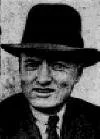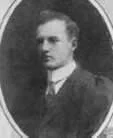Member Biography
Oliver F. Coumans
(1886.12.09 - ?.?.?)
SLS, DLS
Commission #052
(1912.07.26)
Oliver Francis Coumans was born on December 9, 1887 in Chepstow, Ontario. He attended the School of Applied Science at the University of Toronto 1908-1911 and graduated as a Civil Engineer.
“Oliver Cummins came to this world some three and twenty years ago, crying vociferously for a hockey stick and a baseball. In due course he started to the Walkerton High School, graduating with a first-class certificate at the age of seventeen. He was a Knight of the Birch Rod for four years, but finally entered the Class of ’11, taking honors as he proceeded. Oliver has taken an active part in sports, being manager of the Intermediate School Hockey Team, and has also played in the Senior and Intermediate O.H.A. His holidays have been spent prospecting in Gowganda district and on railroad work in the West. During his college course he has made a host of friends, who predict for him an honored and dignified position in the Engineering world.”
When he graduated in 1911, he is shown as being or working for the Provincial Drainage Engineer in Regina.
Oliver was commissioned as both an SLS and a DLS in 1912.
We did not see any plans registered at NRCan and there are no Township surveys in the old Field Books but he did quite a few road surveys around the province between 1912 and 1916.
In the 1916 Census he shows the family (wife and 4 children) name as Coumans yet at the University of Toronto he went by Cummins and over the years he seems to switch back and forth as does his middle name.
“The O.F. Cummins Map Company was established around 1917 in Regina, Saskatchewan. The company’s office was located at 12-2350 12th Avenue (Co-operative Elevator Building). The president of the company, Oliver Francis Coumans, was an engineer and land surveyor. He changed his surname to Cummins around 1917, after which the company was known as the Cummins Map Company. Melville S. Arneil, a draftsman, was vice-president and manager. In 1918, Cummins moved to Winnipeg, Manitoba, where he initially operated a branch office of the company out of his home. The Winnipeg office was later located at 904-457 Main Street and 404-160 Princess Street. Arneil maintained the Regina office until around 1920, when he closed that office and moved to Winnipeg. In 1923, Cummins moved to Toronto, Ontario, followed by Arneil in 1924. The company office was located at 70 Lombard Street. Cummins was involved in other work after 1927 but Arneil continued to manage the company until it ceased to operate in the early 1940s.”
“The main product of the Cummins Map Company was a series of landowner maps, known as the Cummins Rural Directory Maps, for Alberta, Saskatchewan, Manitoba, Ontario and Prince Edward Island. The rural directory maps contained the names and locations of post offices, the location of local rail lines and the names of the owners of each parcel of land within the area covered. The maps were issued as collections of single map sheets instead of being bound in book form as many of the atlases were at the time. The maps were often used by local merchants and travelling salesmen to find customers as well as to assist travelers to find their way across unfamiliar and often unmarked land. The Saskatchewan map series were produced in 1917/1918 (covering most of the settled areas of the province); 1920; 1922; 1926 (covering eastern Saskatchewan) and 1930 (covering north-central Saskatchewan). An uniform sheet numbering system was used and maintained in all series.”
“Some of the other products produced by the Cummins Map Company included an atlas of Prince Edward Island and Cummins Crop Yield Maps, which indicated the crop yields of the prairie provinces using a “good, fair and poor” rating system. The company also advertised their mounting and drafting services.”
From the Brandon Sun October 31, 1932: “Oliver Cummins, Toronto engineer, was the only white person on the day train which left Harbin, Manchuria, September 10, between two night trains, each of which was attacked by bandits, who butchered 115 passengers. He came through nights and days of terror.”
In 1937 Oliver wrote a short (15-20 pgs.) book on the history of Chepstow, Ontario. He used the name Coumans for the book.
According to Toronto City Directories, Oliver was involved with Cummins Map Company until at least 1937 and the company existed well into the 1940’s. It also shows Oliver being a contractor until about 1957.
Oliver married Margaret Eulalia Kelly in 1912. They had at least six children, one of which died in WW2 as a RCAF pilot in 1944. Margaret died in 1923 and Oliver died in 1961 in Seville, Spain while holidaying after a surgery.
Prepared by M. L. J. Waschuk, SLS, P. Surv., 2018
Sources: Library & Archives Canada; ISC; Al Jensen, SLS, Controller; NRCan; University of Toronto Publications; SLSA; Dept. of Interior Publications; Saskatchewan Archival Information Network.



